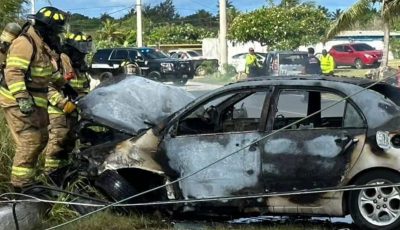Power to the people
I’m going to take a look at a practical, hands-on topic, one that’s a follow-up to a piece on the automotive front, but which has broader applications. In my Jan. 22 column (“Jump!”) I looked at the world of hand-held jump starters. Today I’m going to crank things up a notch, and consider a bigger and heavier device that’s good for jump starting cars, and which can also serve as an electrical source for blackouts, remote job sites, extended beach parties, or camping trips.
I’m not aware of any universal descriptive for these things, so I’ll just call them “power stations,” and leave the jump-starting element implied.
Power stations are typically about the profile of a small laser printer if you stand the printer on its ear. They have handles on the top so you can lug them around. “Lug” is no idle term, given that they typically weigh about 20 lbs.
As useful as they are, they’re sort of tricky to buy for a few reasons. First of all, availability: Their internal lead-acid batteries are sufficiently large that shipping regulations can make things cumbersome. Their heavy weights, furthermore, add to the shipping costs. Therefore on Saipan, or other island markets, local availability is going to be a constraint on your options.
A second element of the equation: Although most power stations look vaguely the same, they don’t all have the same features. Here are six features that I’ve found useful in a power station: (1) jump starter; (2) tire inflator; (3) 12-volt DC power via an automobile-style socket; (4) 5-volt DC power via a USB port; (5) 120-volt AC power via a household-style outlet; (6) small spotlight or floodlight.
A third issue is that one of the most important specifications for these things, which is the capacity of their internal batteries, often goes unmentioned in basic product descriptions.
Let’s peel that subject open right now. The amount of juice that a power station holds is commonly specified in ampere-hours (often abbreviated as “amp-hours”). Since all the models I’m aware of use 12-volt batteries, the ampere-hour figure is something of an apples-to-apples comparison between different models. All else being equal, the bigger this number, the longer it can power the stuff you plug into it.
As a mere consumer, doing my best to scrape by in a technical world that I don’t really understand, I think a decent amp-hour rating for a power station is in the 18 amp-hour to 20 amp-hour range. Some models have less than half that, but you’d never know it from the advertisements. You might have to download an owner’s manual to find this specification, but it’s worth the effort for pre-purchase research.
This leads to another, entirely separate, specification that is commonly trumpeted, which is the peak output in Watts for jump starting. I’ve yet to have a car fail to turn over when zapped with a 1,000-Watt jump starter, so that’s apparently good enough for my fleet of jalopies. Well, that’s just fine, but if you’re using a power station as a power source for your gear, the amount of hours you can power your stuff is tied to the amp-hours, not to the peak Watts.
As for jump-starting, some models have sturdy clamps that open wide enough to get a good bite on a car’s battery terminals. Other models have useless clamps, so this is something to take a look at.
As for tire inflators, I regard them as suitable for very occasional, last-ditch service, but they can indeed (slowly) inflate a tire.
As an electrical source, power stations are useful for devices with very small power needs, such as radios, cell phones, laptop computers, and air mattress pumps. You’re not going to power a microwave, air conditioner, or any other full-fledged appliances with one of these; that stuff needs the muscle of a generator.
To give some sort of perspective, I estimate that my smaller laptop computer could go about 35 hours powered by my power station.
A power station is usually recharged via a normal household AC outlet. Some models come with a dedicated converter that’s necessary for recharging. Me, I’d lose that converter in about three days. Other models just require a standard extension cord. Hey, that’s for me.
As for local pricing, the couple of models I’m aware of that can be ordered from Saipan’s auto parts stores start at about $261, but, again, there’s no standard array of features on these things, so it’s up to the buyer to decide what’s necessary and what isn’t. In a pinch, as long as you’ve got a 12-volt socket on the thing, you can always buy converters, inverters, and portable tire inflators to cover the other needs, so there are work-arounds available if you need them. I’m not good at much, but I’m a maestro at powering everything in life with a 12-volt car socket.
I mostly use my power station for camping. After all, nothing says “back to nature” like having electricity for your computer, so when the simple life calls, my answer is: “Power to the people.”



























